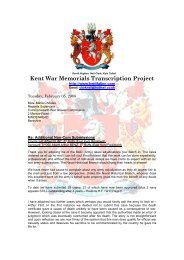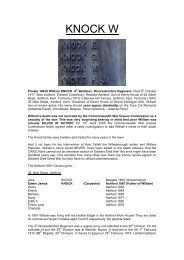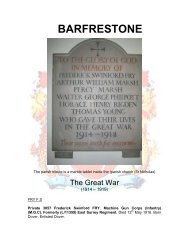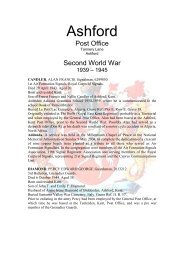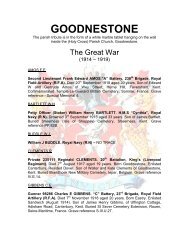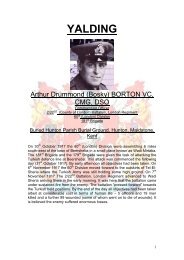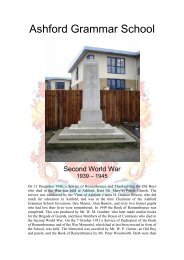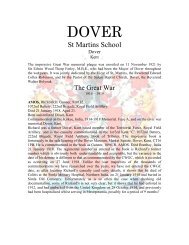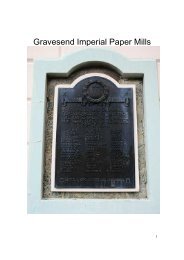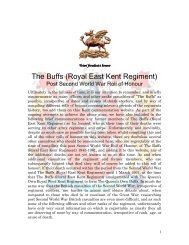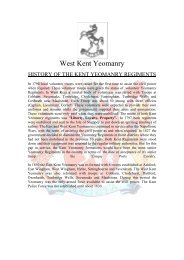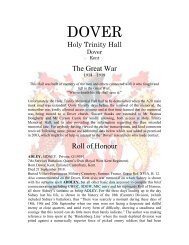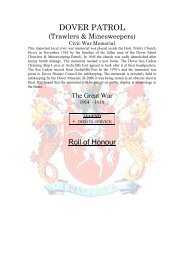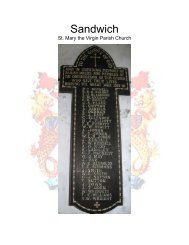KENNINGTON - Kent Fallen
KENNINGTON - Kent Fallen
KENNINGTON - Kent Fallen
You also want an ePaper? Increase the reach of your titles
YUMPU automatically turns print PDFs into web optimized ePapers that Google loves.
to the boat to tea, afterwards going to the RATA concert. It was not a very good turnout<br />
as we had to supply nearly all the singers. While here we fell in with an Indian soldier, of<br />
the Ghurkha regiment. He told us that his regiment was leaving Bombay for the front on<br />
10 th December, and was going in some of the boats that brought us out here. We all had<br />
to be on board by 9.30 pm. At 11.30 pm we marched off the boat to the station, a<br />
distance of nearly half a mile. Arriving at the station we were all served out with one pint<br />
of tea and one blanket each. We then boarded the train and left Bombay about 12.15 am.<br />
After walking about during the day we were a bit tired so we made arrangements for<br />
sleeping directly the train had started and were very soon in dreamland.<br />
We awoke on Thursday morning 3 rd December to find ourselves very stiff and sore<br />
through the huddled up way we had been sleeping in the carriages, if sleep it could be<br />
called for we were awakened many times during the night by the sudden jars and<br />
sharpness of the curves in the railroad. We were travelling through the plains and<br />
farming districts of India. It was a fine sight to see how the different products of<br />
vegetation grow. There is a large number of tobacco plantations or fields all along the<br />
line. The tobacco plants are not unlike English cauliflower in appearance. They grow<br />
about the same height, but without a white head, and the leaves are the same shape, but a<br />
little darker in colour. Bananas, oranges, pineapples and dates can also be seen growing<br />
in gardens and plantations. The bananas look very pretty as they grow in large clusters of<br />
between two and three hundred on a stalk. They are not yellow as you buy them in<br />
England, but green. They turn yellow after they have been picked. Some of them are<br />
yellow, but these are only what are kept for sale in this country. Oranges grow on large<br />
trees similar to apples in England. They also are picked when green. Pineapples grow<br />
about the same as wurzels with the exception of the leaves. These are the same as wide<br />
rushes or flag leaves. Dates grow like plums and look nearly as such before being<br />
preserved and packed in boxes. They have an eye on one and practically the same as<br />
those that are found on oranges. At intervals along the line cotton factories can be seen.<br />
These are where the seeds are separated from the raw cotton. Cotton is grown in fields<br />
like farmers grow peas in England. It first blooms with a flower something like the<br />
English orange blossom. When this falls off it leaves a bud like a large lily bud. After a<br />
time this bud bursts and the cotton comes out like pieces of sheep’s wool that are found<br />
in brambles. In this the seeds are found. No matter how long it is left it will never drop<br />
from the bud. It is a good thing that it does not drop, because it all has to be picked and is<br />
therefore kept clean. We stopped twice on our journey during the day first for breakfast<br />
at 9.30 am, and for dinner at 3.00 pm. Our tea was issued to us at dinner time.<br />
We arrived at Nagpur at 5.00 am on Friday 4 th December. It was here we had our<br />
breakfast. It was A Company that was left at this station that they might go to fort<br />
Situbaldi which is in Nagpur. Each company has to take its turn of a fortnight at this fort.<br />
The rest of us went on our journey and arrived at Kamptee at 7.30 am after a train ride of<br />
two nights and one day. We unloaded our baggage from the train and put it on the oxen<br />
vans, or garkis as they are called. After a march of 3 ½ miles we arrived on the camp. It<br />
was then ten o’clock. We were shown our bungalows and taken to the RATA rooms for<br />
dinner by companies. During the rest of the day we were kept very busy drawing our<br />
beds and kit, and getting our places a bit straight and clean. The climate here is very hot.<br />
36



